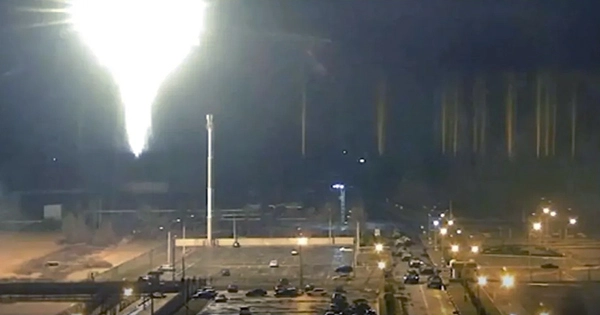Overnight, a fire broke out in a training facility at Ukraine’s Zaporizhzhia Nuclear Power Plant, which was assumed to have been sparked by Russian shelling, but according to current reports, it was extinguished before spreading to the reactors. However, the plant was later taken by Russian forces, raising concerns about future operations and radiation monitoring there. A fire will not necessarily cause a meltdown, according to nuclear physicists, because radiation levels are now steady and safety procedures have improved substantially in the 36 years since Chernobyl. If safety measures are not followed, a meltdown will be “ten times worse than Chernobyl,” according to Ukrainian Foreign Minister Dmytro Kuleba, but this is likely an exaggeration spurred on by the stress of war.
The Zaporizhzhia power station is Europe’s biggest, supplying about a fifth of Ukraine’s electricity. With temperatures in Kyiv expected to stay around 0o C (32o F) for the next 48 hours, cutting off supplies would be a big victory in Russian efforts to compel the Ukrainian people into submission. Russia told the International Atomic Energy Agency yesterday that it had seized land near the reactor. The quickest method to shut off Ukraine’s energy supply would have been to cut transmission lines from Zaporizhzhia, but the assaulting forces appear to have instead ignited a fire, either intentionally or by mistake.
Overnight Ukraine time, live streams of the location on the power plants’ Youtube Channel drew millions of views, but while recordings are still online, current photos do not appear to be available. The Ukrainian state emergency service, on the other hand, announced on Facebook that the fire had been extinguished with “no casualties.”
Naturally, fears of a nuclear explosion arose, although the likelihood of such an event is remote. Uranium-235 must account for at least 85 percent of the nuclear material in nuclear weapons. Power plants like Zaporizhzhia, on the other hand, employ fuel that is just a few percent U-235 enriched from the naturally occurring 0.7 percent, but incapable of creating a bomb without substantial processing.
A more realistic concern is a nuclear meltdown, such as the one that occurred in 1986 at Chernobyl, also in Ukraine, and dispersed radioactive throughout much of Europe. The risk, according to Dr. Tony Irwin of the Australian National University, is low: “The six nuclear power reactors at Zaporizhzhia are not Chernobyl-type reactors… They have a containment surrounding the reactor, unlike Chernobyl, to prevent any radioactive leakage. Unlike the Fukushima reactors, these VVER reactors feature separate water circuits for cooling and steam production.
These reactors contain emergency core cooling systems consisting of four hyroaccumulators that will passively pump cooling water into the reactor in the case of a failure, in addition to the usual cooling systems. To avoid a core melt, they have several train high and low-pressure injection systems.” “The good news is that radiation levels surrounding the facility are generally normal, and 5 of the 6 reactors have now been shut off, with one still working,” said Professor Tom Scott of the University of Bristol.
“I’m not afraid that unintentional harm may result in a huge nuclear disaster.” Others pointed out that spent nuclear material stored nearby might be more vulnerable, albeit the magnitude of the event would be lower. The truth is now difficult to ascertain in the fog of battle. According to other sources, the fire was contained to a training facility, and emergency responders were able to rapidly get entry to put it out. Others said that rescuers were unable to approach the station. “We also need to determine if the plant has been shut down, and where external electricity is coming from,” Monash University’s Dr Maria Rost Rublee said. If the grid goes down, we’ll have to rely on backup diesel generators, which are a huge fire danger.”















